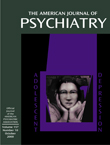Factor Analysis of the DSM-III-R Borderline Personality Disorder Criteria in Psychiatric Inpatients
Abstract
OBJECTIVE: The goal of this study was to examine the factor structure of the DSM-III-R criteria for borderline personality disorder in young adult psychiatric inpatients. METHOD: The authors assessed 141 acutely ill inpatients with the Personality Disorder Examination, a semistructured diagnostic interview for DSM-III-R personality disorders. They used correlational analyses to examine the associations among the different criteria for borderline personality disorder and performed an exploratory factor analysis. RESULTS: Cronbach’s coefficient alpha for the borderline personality disorder criteria was 0.69. A principal components factor analysis with a varimax rotation accounted for 57.2% of the variance and revealed three homogeneous factors. These factors were disturbed relatedness (unstable relationships, identity disturbance, and chronic emptiness); behavioral dysregulation (impulsivity and suicidal/self-mutilative behavior); and affective dysregulation (affective instability, inappropriate anger, and efforts to avoid abandonment). CONCLUSIONS: Exploratory factor analysis revealed three homogeneous components of borderline personality disorder that may represent personality, behavioral, and affective features central to the disorder. Recognition of these components may inform treatment plans.



